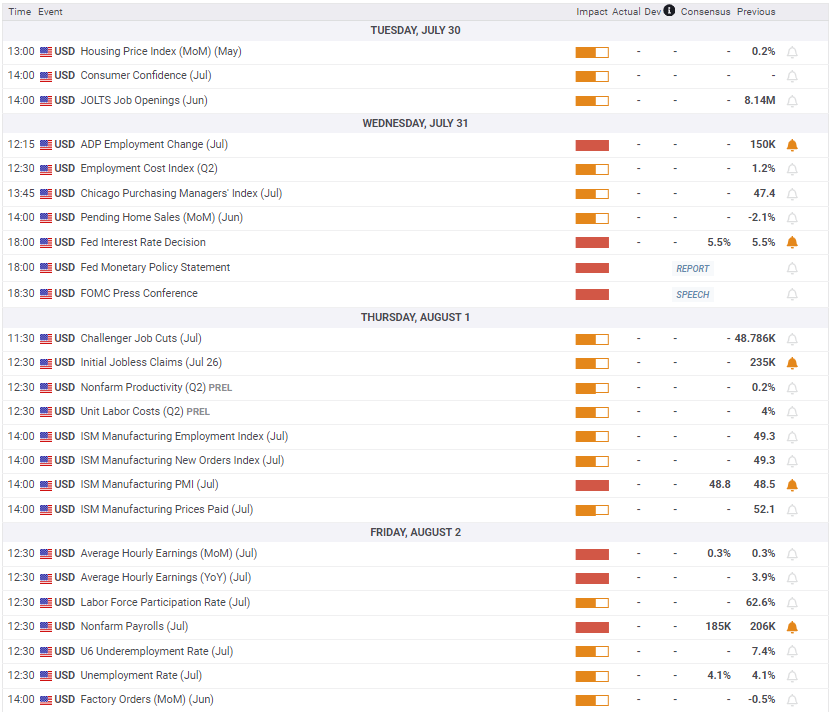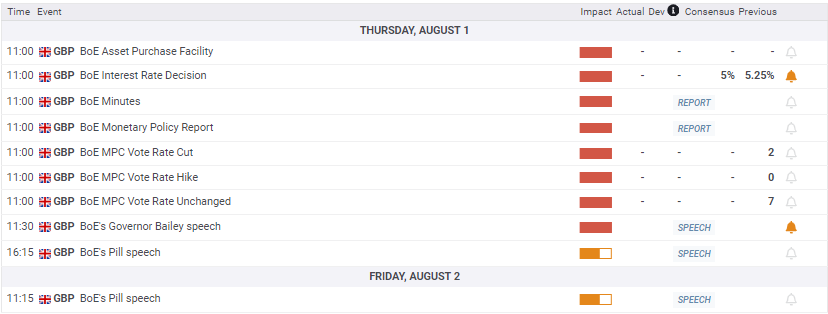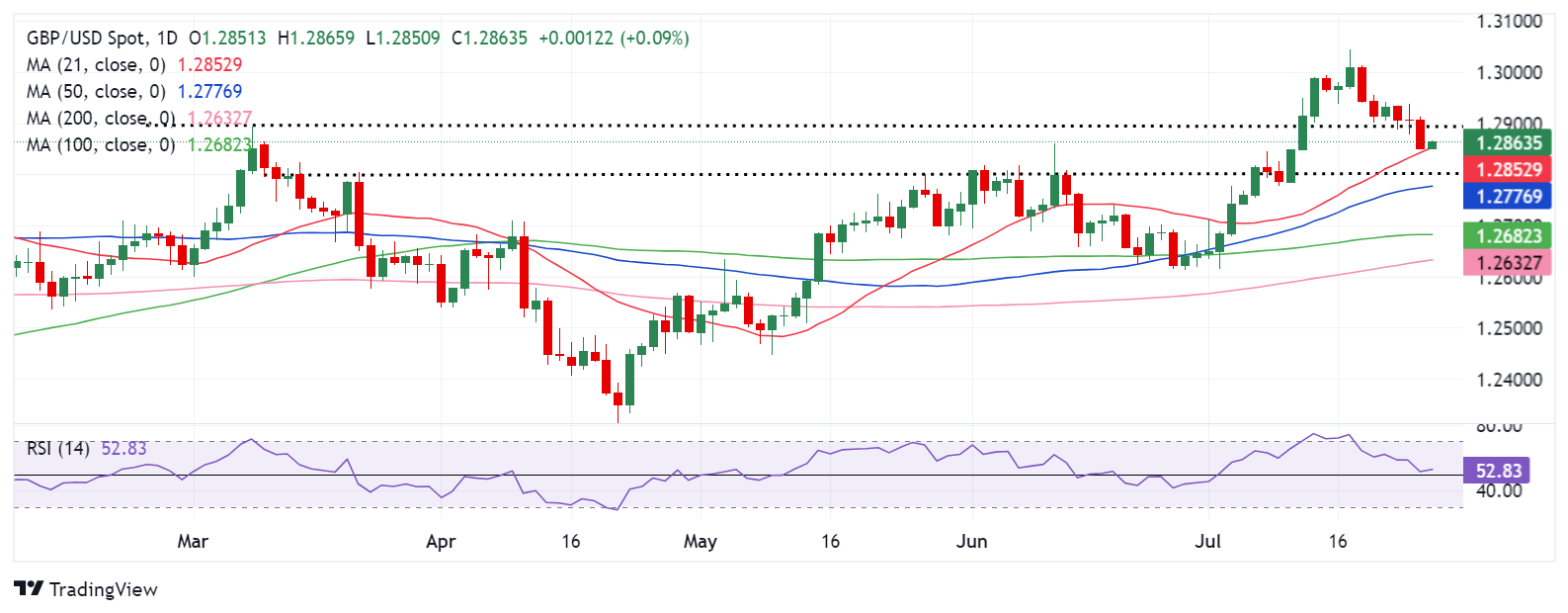- The Pound Sterling extended its pullback from yearly highs against the US Dollar.
- GBP/USD still seems like a ‘buy-the-dips’ trade heading into the Fed and BoE policy meetings.
- Pound Sterling buyers stay hopeful, as technicals remain favorable.
The Pound Sterling (GBP) stretched its corrective downside from yearly highs against the US Dollar (USD), sending GBP/USD back under 1.2900 – the lowest level in over a week.
Pound Sterling succumbed amid heightened risk aversion
GBP/USD maintained its corrective downside mode during the past week, despite a broadly rangebound US Dollar. Divergent monetary policy outlooks between the US Federal Reserve (Fed) and the Bank of England (BoE) also failed to offer the much-needed lift to the Pound Sterling, as the sentiment around the higher-yielding currency was dented by resurfacing concerns over China’s economic slowdown.
Markets turned risk averse after policymakers at China’s Third Plenum failed to roll out any strong policy measures to stimulate the post-pandemic economic recovery. Additionally, surprise interest rate cuts by the People’s Bank of China (PBOC) and several Chinese state-owned banks accentuated mounting worries over China’s economic prospects.
China's central bank, cut the one-year Medium-term Lending Facility (MLF) rate from 2.50% to 2.30% on Thursday. Industrial and Commercial Bank of China (ICBC), Agricultural Bank of China (AgBank), China Construction Bank, Bank of China and Bank of Communications cut deposit rates by 5 to 20 basis points (bps), according to statements on their websites.
This combined with an unimpressive start to the earnings reports from the “Magnificent Seven” megacap technology companies kept the market environment dour. Although Google parent Alphabet delivered a beat on both the top and bottom lines, the company’s chief signaled patience will be needed to see concrete results from artificial intelligence investments. Meanwhile, Tesla fell as much as 7% after profit fell short of estimates and the electric-vehicle giant delayed its Robotaxi event to October.
The USD, however, was unable to take advantage of the risk-off sentiment, as it bore the brunt of the relentless USD/JPY sell-off. The Japanese Yen rebounded firmly to three-month highs against the Greenback on carry trades unwinding, courtesy of heightening expectations that the Bank of Japan (BoJ) will hike rates by 10 basis points (bps) next Wednesday. Additionally, markets fully priced in a September Fed rate cut, weighing negatively on the buck.
Nonetheless, the upbeat US Gross Domestic Product (GDP) for the second quarter of 2024, alongside a sharp USD/JPY upswing, did offer some saving grace to USD buyers toward the end of the week. But expectations of a softer US core Personal Consumption Expenditures (PCE) Price Index, the Fed’s preferred inflation measure, curbed the US Dollar’s enthusiasm, lifting the GBP/USD pair from near 1.2850 key demand area.
On Thursday, the core PCE deflator rose 2.9% at an annualized rate in Q2, down from 3.7% in the previous quarter, indicating a moderation in inflationary pressure,” analysts at RBC Economics noted. Meanwhile, the US economy expanded at an annualized rate of 2.8% in Q2 2024, doubling from the 1.4% growth reported in the previous quarter.
The US Bureau of Economic Analysis reported on Friday that inflation in the US, as measured by the change in the PCE Price Index, edged lower to 2.5% on a yearly basis in June from 2.6% in May. The core PCE Price Index, which excludes volatile food and energy prices, rose 2.6% in the same period, matching May's increase. GBP/USD showed little to no reaction to these data ahead of the weekend.
All eyes on Fed, BoE policy decisions and Nonfarm Payrolls
Another action-packed week unfolds for the Pound Sterling, as all the attention remains centered on the policy announcements by the Fed and the BoE on Wednesday and Thursday respectively.
Monday is quiet, in terms of any macro releases from both sides of the Atlantic while Tuesday will feature the BoE Quarterly Bulletin, US CB Consumer Confidence and JOLTS Job Openings survey.
The Fed and BoE interest rate decision and banks’ outlook on rates will set the tone for the Pound Sterling markets in the coming weeks. Markets have fully priced in a September Fed rate cut. On the other hand, interest rate futures are pricing a 51% chance that the BoE will reduce rates by 25 bps next week while projecting 54 bps of cuts for 2024, up from 49 bps of cuts on Wednesday.
The weekly US Jobless Claims and the ISM Manufacturing PMI will be published on Thursday, following the BoE events.
The all-important US Nonfarm Payrolls will hog the limelight on Friday, as Fed policymakers return after a two-week ‘blackout period’. BoE Chief Economist Huw Pill is also due to speak on Friday.
GBP/USD: Technical Outlook
The Pound Sterling correction is seen paving the way for a fresh uptrend, as portrayed by the GBP/USD daily chart.
The 14-day Relative Strength Index (RSI) has stalled its descent and holds above the 50 level, currently near 52.50, suggesting that buyers still remain in the game.
However, a daily candlestick close below the key 21-day Simple Moving Average (SMA) support at 1.2851 will shake off any odds for a recovery.
On a renewed downside, the immediate cushion will be seen at the previous key resistance near 1.2800.
Further south, the 50-day SMA at 1.2777 will be tested, exposing sellers to the 100-day SMA at 1.2682.
Alternatively, recapturing the weekly high of 1.2942 is critical to initiate a fresh uptrend toward the yearly high of 1.3045.
Ahead of that level, the 1.3000 round figure will challenge the bearish commitments.
Pound Sterling FAQs
The Pound Sterling (GBP) is the oldest currency in the world (886 AD) and the official currency of the United Kingdom. It is the fourth most traded unit for foreign exchange (FX) in the world, accounting for 12% of all transactions, averaging $630 billion a day, according to 2022 data. Its key trading pairs are GBP/USD, aka ‘Cable’, which accounts for 11% of FX, GBP/JPY, or the ‘Dragon’ as it is known by traders (3%), and EUR/GBP (2%). The Pound Sterling is issued by the Bank of England (BoE).
The single most important factor influencing the value of the Pound Sterling is monetary policy decided by the Bank of England. The BoE bases its decisions on whether it has achieved its primary goal of “price stability” – a steady inflation rate of around 2%. Its primary tool for achieving this is the adjustment of interest rates. When inflation is too high, the BoE will try to rein it in by raising interest rates, making it more expensive for people and businesses to access credit. This is generally positive for GBP, as higher interest rates make the UK a more attractive place for global investors to park their money. When inflation falls too low it is a sign economic growth is slowing. In this scenario, the BoE will consider lowering interest rates to cheapen credit so businesses will borrow more to invest in growth-generating projects.
Data releases gauge the health of the economy and can impact the value of the Pound Sterling. Indicators such as GDP, Manufacturing and Services PMIs, and employment can all influence the direction of the GBP. A strong economy is good for Sterling. Not only does it attract more foreign investment but it may encourage the BoE to put up interest rates, which will directly strengthen GBP. Otherwise, if economic data is weak, the Pound Sterling is likely to fall.
Another significant data release for the Pound Sterling is the Trade Balance. This indicator measures the difference between what a country earns from its exports and what it spends on imports over a given period. If a country produces highly sought-after exports, its currency will benefit purely from the extra demand created from foreign buyers seeking to purchase these goods. Therefore, a positive net Trade Balance strengthens a currency and vice versa for a negative balance.
Information on these pages contains forward-looking statements that involve risks and uncertainties. Markets and instruments profiled on this page are for informational purposes only and should not in any way come across as a recommendation to buy or sell in these assets. You should do your own thorough research before making any investment decisions. FXStreet does not in any way guarantee that this information is free from mistakes, errors, or material misstatements. It also does not guarantee that this information is of a timely nature. Investing in Open Markets involves a great deal of risk, including the loss of all or a portion of your investment, as well as emotional distress. All risks, losses and costs associated with investing, including total loss of principal, are your responsibility. The views and opinions expressed in this article are those of the authors and do not necessarily reflect the official policy or position of FXStreet nor its advertisers. The author will not be held responsible for information that is found at the end of links posted on this page.
If not otherwise explicitly mentioned in the body of the article, at the time of writing, the author has no position in any stock mentioned in this article and no business relationship with any company mentioned. The author has not received compensation for writing this article, other than from FXStreet.
FXStreet and the author do not provide personalized recommendations. The author makes no representations as to the accuracy, completeness, or suitability of this information. FXStreet and the author will not be liable for any errors, omissions or any losses, injuries or damages arising from this information and its display or use. Errors and omissions excepted.
The author and FXStreet are not registered investment advisors and nothing in this article is intended to be investment advice.
Recommended Content
Editors’ Picks

EUR/USD struggles to hold above 1.0400 as mood sours
EUR/USD stays on the back foot and trades near 1.0400 following the earlier recovery attempt. The holiday mood kicked in, keeping action limited across the FX board, while a cautious risk mood helped the US Dollar hold its ground and forced the pair to stretch lower.

GBP/USD approaches 1.2500 on renewed USD strength
GBP/USD loses its traction and trades near 1.2500 in the second half of the day on Monday. The US Dollar (USD) benefits from safe-haven flows and weighs on the pair as trading conditions remain thin heading into the Christmas holiday.

Gold hovers around $2,610 in quiet pre-holiday trading
Gold struggles to build on Friday's gains and trades modestly lower on the day near $2,620. The benchmark 10-year US Treasury bond yield edges slightly higher above 4.5%, making it difficult for XAU/USD to gather bullish momentum.

Bitcoin fails to recover as Metaplanet buys the dip
Bitcoin hovers around $95,000 on Monday after losing the progress made during Friday’s relief rally. The largest cryptocurrency hit a new all-time high at $108,353 on Tuesday but this was followed by a steep correction after the US Fed signaled fewer interest-rate cuts than previously anticipated for 2025.

Bank of England stays on hold, but a dovish front is building
Bank of England rates were maintained at 4.75% today, in line with expectations. However, the 6-3 vote split sent a moderately dovish signal to markets, prompting some dovish repricing and a weaker pound. We remain more dovish than market pricing for 2025.

Best Forex Brokers with Low Spreads
VERIFIED Low spreads are crucial for reducing trading costs. Explore top Forex brokers offering competitive spreads and high leverage. Compare options for EUR/USD, GBP/USD, USD/JPY, and Gold.


